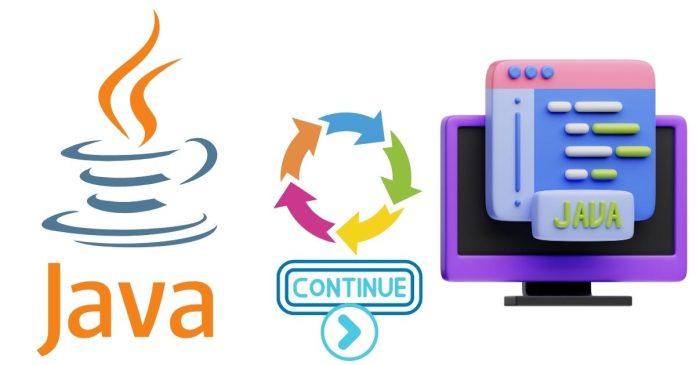The continue statement in Java is used to skip the current iteration of a loop and jump to the next iteration. It is commonly used when you want to bypass certain parts of the loop based on a condition but still continue looping.
The continue statement works with all types of loops in Java, including for, while, and do-while
Syntax of the continue Statement
continue;
The continue statement is usually placed inside a conditional block within the loop.
How the continue Statement Works
When the continue statement is executed:
- The loop immediately skips the remaining code for the current iteration.
- Control jumps to the next iteration of the loop.
- In a
forloop, the update statement is executed before proceeding to the next iteration. - In a
whileordo-whileloop, the condition is re-evaluated before the next iteration begins.
Example: Using continue in a for Loop
public class Main {
public static void main(String[] args) {
for (int i = 1; i <= 5; i++) {
if (i == 3) {
continue; // Skip the rest of the loop when i == 3
}
System.out.println("i = " + i);
}
}
}
Output:
i = 1
i = 2
i = 4
i = 5
In this example, the loop skips printing the value 3 and continues with the next iteration.
Example: Using continue in a while Loop
public class Main {
public static void main(String[] args) {
int i = 1;
while (i <= 5) {
if (i == 3) {
i++; // Increment before continue to avoid an infinite loop
continue; // Skip the rest of the loop for i == 3
}
System.out.println("i = " + i);
i++;
}
}
}
Output:
i = 1
i = 2
i = 4
i = 5
Example: Using continue in a Nested Loop
The continue statement can also be used in nested loops. When used inside an inner loop, it skips the current iteration of that loop only.
public class Main {
public static void main(String[] args) {
for (int i = 1; i <= 3; i++) {
for (int j = 1; j <= 3; j++) {
if (j == 2) {
continue; // Skip the rest of the inner loop when j == 2
}
System.out.println("i = " + i + ", j = " + j);
}
}
}
}
Output:
i = 1, j = 1
i = 1, j = 3
i = 2, j = 1
i = 2, j = 3
i = 3, j = 1
i = 3, j = 3
Example: Labeled continue Statement
Java allows the use of labels with continue to skip iterations of an outer loop. A label is a name followed by a colon, placed before the loop.
public class Main {
public static void main(String[] args) {
outerLoop:
for (int i = 1; i <= 3; i++) {
for (int j = 1; j <= 3; j++) {
if (j == 2) {
continue outerLoop; // Skip to the next iteration of the outer loop
}
System.out.println("i = " + i + ", j = " + j);
}
}
}
}
Output:
i = 1, j = 1
i = 2, j = 1
i = 3, j = 1
Key Points to Remember
- The
continuestatement skips the current iteration of a loop and moves to the next iteration. - In a
forloop, the update statement is executed before the next iteration. - In a
whileordo-whileloop, the condition is checked again before proceeding. - Labeled
continuecan be used to skip iterations of an outer loop in nested loops.
When to Use the continue Statement
- To skip specific iterations based on a condition.
- To make the code more readable by avoiding unnecessary
if-elsenesting. - In nested loops, to skip specific iterations of inner or outer loops using labels.
The continue statement in Java is a handy tool for controlling the flow of loops. It helps developers skip certain iterations without breaking out of the loop entirely. By understanding how and when to use continue, you can write cleaner and more efficient loop-based code.


